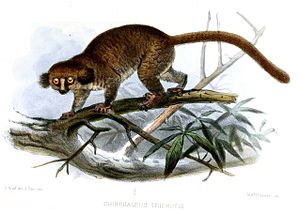Tussock lemur
| Tussock lemur | ||||||||||||
|---|---|---|---|---|---|---|---|---|---|---|---|---|

Tussock lemur ( Allocebus trichotis ) |
||||||||||||
| Systematics | ||||||||||||
|
||||||||||||
| Scientific name of the genus | ||||||||||||
| Allocebus | ||||||||||||
| Petter-Rousseaux & Petter , 1967 | ||||||||||||
| Scientific name of the species | ||||||||||||
| Allocebus trichotis | ||||||||||||
| ( Günther , 1875) |
The hairy-eared dwarf lemur or Büschelohrige cheirogaleidae ( Allocebus trichotis ) is a primate species from the family of lemurs within the lemurs .
description
Tufted lemurs reach a head body length of 12 to 16 centimeters, in addition there is a 14 to 20 centimeter long tail. Their weight is 65 to 90 grams. Their fur is gray-brown on the top and whitish on the underside. The name-giving feature is the tuft-like hair that grows out of the auricles. The muzzle is elongated and rounded, the hind legs are significantly stronger than the front legs and the tail is longer than the body. As with all wet-nosed monkeys , the incisors and canines of the lower jaw form a tooth comb , the tongue is greatly elongated. They resemble mouse lemurs in appearance , but have longer tails and longer hind legs.
distribution and habitat
Like all lemurs, tufted lemurs only occur in Madagascar . Until the 1980s, the species was only known from a few places on the east coast, meanwhile occurrences have been discovered in several regions, their range includes the north-east of Madagascar according to current knowledge. Their habitat is rainforests up to an altitude of 1600 meters, but they prefer to stay in areas below 1000 meters.
Way of life
These primates are nocturnal and spend the day in tree hollows, which they pad with leaves. At night they go in search of food. In the drier months of June to September they hibernate, for which they create fat reserves in their body.
Little is known about their diet, but the teeth suggest that they feed primarily on tree sap , similar to the lemurs . Insects should complement their menu.
Little is known about their social behavior either, they probably live in monogamous couples. A single young is usually born in January or February.
threat
Tufted lemurs are considered rare animals. They live in a small area in northeastern Madagascar and are threatened by the clearing of the rainforests, and their meat is eaten by the local population. After their first description in 1875, the animals were not seen for almost a hundred years, and were not found again until 1966. Then it took another twenty years until tufted lemurs were sighted again in 1989. Since then, they have been observed more regularly. In the 1990s, they were "threatened with extinction" as a ( critically endangered ), but in the meantime other populations have been discovered so that the IUCN in 2000 the level of danger to "high risk" ( endangered ) was downgraded. The status is now "insufficient data" ( data deficient ).
The species is no longer kept in Europe, the former owner is Paris.
literature
- Nick Garbutt: Mammals of Madagascar. A Complete Guide. Yale University Press, New Haven CT 2007, ISBN 978-0-300-12550-4 .
- Thomas Geissmann : Comparative Primatology. Springer-Verlag, Berlin et al. 2002, ISBN 3-540-43645-6 .
- Ronald M. Nowak: Walker's Mammals of the World. 6th edition. Johns Hopkins University Press, Baltimore MD 1999, ISBN 0-8018-5789-9 .
supporting documents
Web links
- Photos and information at arkive.org
- Allocebus trichotis onthe IUCN Red List of Threatened Species . Retrieved April 17, 2009.